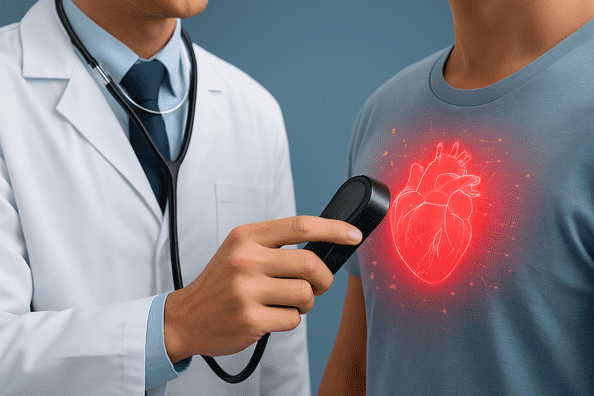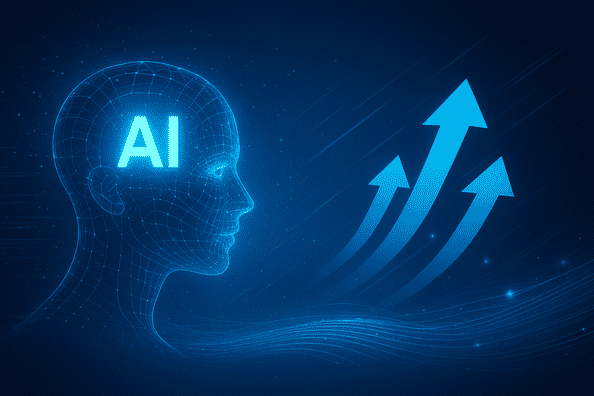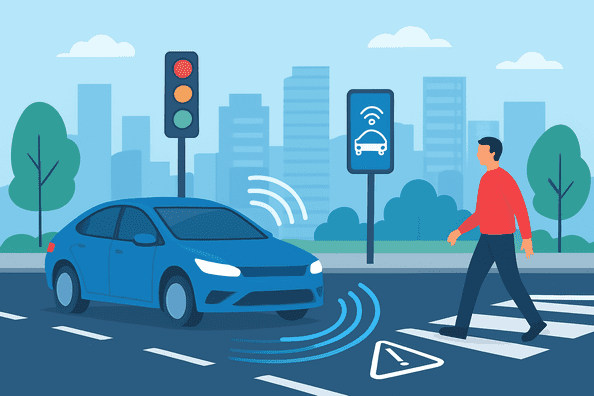The humble stethoscope, an iconic symbol of medicine for over 200 years, is experiencing its most significant transformation yet. The AI stethoscope is revolutionizing how physicians detect cardiovascular diseases, bringing unprecedented precision to the art of auscultation. In an era where early detection can mean the difference between life and death, doctors worldwide are embracing this intelligent diagnostic tool with remarkable enthusiasm and trust.
Recent breakthrough studies involving over 12,000 patients across 200 UK clinics have demonstrated that AI stethoscopes can detect three critical heart conditions—heart failure, atrial fibrillation, and heart valve disease—in just 15 seconds. This isn’t just an incremental improvement; it represents a paradigm shift in cardiac diagnostics that’s earning the confidence of medical professionals everywhere.
The Revolutionary Technology Behind AI Stethoscopes
Beyond Traditional Auscultation
Unlike conventional stethoscopes that rely solely on a physician’s trained ear, the AI stethoscope combines advanced sensors, machine learning algorithms, and cloud-based analytics to create a comprehensive diagnostic platform. The device features a playing-card-sized chest piece equipped with high-sensitivity microphones and sensors that capture both heart sounds and electrical signals through an integrated ECG function.
The magic happens in the cloud, where artificial intelligence algorithms trained on datasets from tens of thousands of patients analyze the captured audio patterns. These sophisticated algorithms can detect subtle variations in heartbeat and blood flow that are imperceptible to human hearing, providing doctors with insights that would otherwise require expensive specialized equipment.
Real-Time Diagnostic Power
What sets the AI stethoscope apart is its ability to deliver near-instantaneous results. Within 15 seconds of placing the device on a patient’s chest, doctors receive diagnostic insights through a smartphone application. This rapid analysis capability transforms routine checkups into powerful screening opportunities, allowing physicians to identify potentially life-threatening conditions before symptoms manifest.
The technology works by comparing patient data against vast databases of previously diagnosed cases, utilizing pattern recognition to identify acoustic signatures associated with specific cardiac conditions. This approach combines the familiarity of traditional stethoscope examination with the analytical power of artificial intelligence, creating a tool that enhances rather than replaces clinical judgment.
Clinical Evidence That Builds Medical Trust
Groundbreaking Study Results
The medical community’s trust in AI stethoscopes is built on solid clinical evidence. The landmark study conducted by Imperial College London and Imperial College Healthcare NHS Trust involved over 12,000 patients across 96 GP surgeries, comparing outcomes with 109 control practices that used traditional diagnostic methods.
The results were striking and have fundamentally changed how doctors view this technology:
- Heart failure detection increased by 2.3 times compared to standard practice
- Atrial fibrillation identification rose by 3.5 times, particularly significant since this condition often presents without symptoms
- Heart valve disease diagnosis nearly doubled, catching conditions that might otherwise progress undetected.
These aren’t marginal improvements—they represent dramatic enhancements in diagnostic capability that directly translate to better patient outcomes and earlier interventions.
Impressive Accuracy Metrics
Multiple validation studies have demonstrated the AI stethoscope’s reliability across different clinical settings. In specialized studies focusing on aortic stenosis, the technology achieved:
- 86% sensitivity and 100% specificity in the initial derivation group
- 84% sensitivity and 92% specificity in validation testing
- 90% sensitivity and 84% specificity in real-world clinical environments
These performance metrics compare favorably to many established diagnostic tools and have convinced skeptical physicians of the technology’s clinical value.
Real-World Success Stories and Physician Experiences
Transforming Primary Care Practice
The technology has proven particularly valuable in primary care settings where access to echocardiography and specialist consultations may be limited. Rural practitioners, in particular, have found the AI stethoscope bridges crucial gaps in specialized diagnostic capabilities.
Healthcare providers report that the device enables them to identify patients with heart failure who had no symptoms and would likely have been diagnosed months later during an emergency admission. The confidence this tool provides in making referral decisions has been described as invaluable by participating physicians.
Emergency Department Applications
Emergency physicians have embraced AI stethoscopes for their ability to rapidly triage patients with chest complaints. The 15-second diagnostic capability has been described as a game-changer in fast-paced emergency environments, helping clinicians quickly identify patients who need immediate cardiac workup versus those who can be safely discharged with outpatient follow-up.
Specialty Cardiology Integration
Even cardiologists, initially skeptical of AI-assisted diagnosis, have found value in the technology. The AI stethoscope doesn’t replace clinical judgment, but provides additional data points that enhance assessment, particularly useful for detecting subtle murmurs that might be missed during busy clinic days.
Why Physicians Trust This Technology
Addresses Critical Healthcare Challenges
The medical community’s trust in AI stethoscopes stems from their ability to address several critical challenges facing modern healthcare:
- Diagnostic Consistency: The technology reduces variability in auscultation skills between practitioners, ensuring more consistent diagnostic standards across different healthcare settings.
- Early Detection Imperative: With cardiovascular disease remaining the leading cause of mortality worldwide, any tool that enables earlier detection addresses a fundamental healthcare priority.
- Resource Optimization: By improving diagnostic accuracy in primary care settings, AI stethoscopes reduce unnecessary referrals while ensuring appropriate cases receive timely specialist attention.
Training Enhancement: The technology serves as an educational tool, helping medical students and residents develop better auscultation skills by providing immediate feedback on their assessments.
Seamless Integration with Clinical Workflow
Unlike many new medical technologies that require significant workflow changes, AI stethoscopes integrate naturally into existing examination routines. The familiar form factor and examination technique mean physicians can adopt the technology without disrupting their established patient interaction patterns.
The device’s smartphone connectivity allows for easy documentation, with results automatically integrated into electronic health records. This seamless data flow enhances clinical decision-making while supporting quality improvement initiatives.
The FDA Endorsement Factor
Regulatory Validation
Physician trust in AI stethoscopes has been significantly bolstered by regulatory approvals from the FDA and other international health authorities. Eko Health’s AI algorithms have received multiple 510(k) clearances, including specific approvals for:
- Low ejection fraction detection
- Atrial fibrillation identification
- Heart murmur analysis
- Structural heart disease screening
These regulatory endorsements provide physicians with confidence that the technology meets rigorous safety and efficacy standards required for clinical use.
Clinical Guidelines Integration
Healthcare systems are developing specific clinical guidelines for AI stethoscope use, providing physicians with clear protocols for interpreting and acting on AI-generated insights. The NHS North West London Integrated Care System and other health networks have established standardized approaches to incorporating AI stethoscope findings into patient care pathways.
Addressing Physician Concerns and Limitations
Understanding False Positive Rates
While AI stethoscopes offer remarkable diagnostic capabilities, physicians have learned to interpret results within clinical context. Studies indicate that approximately two-thirds of patients flagged for heart failure may not have the condition upon follow-up testing, highlighting the importance of using AI insights as screening tools rather than definitive diagnoses.
Physicians view the AI stethoscope as an incredibly sensitive screening tool. When it flags a potential issue, they know to investigate further rather than accepting the result as a final diagnosis. This approach has led to earlier detection of several serious conditions in clinical practice.
Training and Adaptation
Successful AI stethoscope implementation requires physician training and adaptation. Healthcare systems typically provide one-session training programs covering:
- Device setup and smartphone application use
- Proper examination technique and signal capture
- Result interpretation and clinical action guidelines
- Integration with existing documentation systems
The relatively short learning curve has contributed to physician acceptance, with most practitioners becoming comfortable with the technology within their first few uses.
Cost-Effectiveness and Healthcare Value
Economic Impact on Healthcare Systems
The economic case for AI stethoscopes has strengthened physician and administrator support for the technology. Traditional cardiac diagnostic pathways often involve multiple appointments, expensive imaging studies, and specialist referrals that may be unnecessary.
AI stethoscopes offer several cost advantages:
- Reduced unnecessary referrals by providing more accurate initial assessments
- Earlier intervention that prevents costly emergency admissions
- Improved diagnostic efficiency in primary care settings
- Enhanced preventive care capabilities that reduce long-term healthcare costs
Heart failure admission alone costs the UK over £2 billion annually, with 80% of diagnoses made during emergency admissions. The potential for AI stethoscopes to shift diagnosis to primary care settings represents significant cost savings opportunities.
Market Growth and Investment
The AI-powered stethoscope market is projected to reach $111.6 million by 2035, reflecting growing confidence in the technology among healthcare investors and providers. This market growth indicates sustainable development and continued innovation in the field.
Training the Next Generation
Medical Education Integration
Medical schools and residency programs are increasingly incorporating AI stethoscopes into their training curricula. The technology serves dual purposes as both a diagnostic tool and an educational aid, helping students develop better auscultation skills while introducing them to AI-assisted medicine.
Students using AI stethoscopes develop more confidence in their diagnostic abilities and better understand the nuances of cardiac auscultation. The immediate feedback helps accelerate their learning curve significantly.
Continuing Medical Education
Practicing physicians are participating in continuing education programs focused on AI stethoscope use and interpretation. These programs address both technical aspects of the device and broader implications of AI integration in clinical practice.
Global Impact and Accessibility
Democratizing Cardiac Diagnostics
One of the most compelling aspects of AI stethoscope technology is its potential to democratize access to high-quality cardiac diagnostics. In resource-limited settings where specialist care may be scarce, these devices can provide sophisticated diagnostic capabilities to general practitioners and community health workers.
The technology has transformed the ability to detect heart conditions in challenging environments. For example, in pregnancy-related heart failure screening in Nigeria, where more women experience this condition than anywhere in the world, AI stethoscopes helped doctors identify twice as many cases compared to usual obstetric care.
Telemedicine Integration
The digital nature of AI stethoscopes makes them ideal for telemedicine applications. Recorded heart sounds and AI analysis can be shared with specialists remotely, enabling expert consultation even in geographically isolated areas.
Future Innovations and Development
Expanding Diagnostic Capabilities
Current research is extending AI stethoscope capabilities beyond cardiac conditions to include:
- Respiratory disease detection including pneumonia and asthma
- Pulmonary hypertension screening
- Multi-organ system assessment combining cardiac and pulmonary analysis
- Pediatric-specific algorithms optimized for children’s physiology
Wearable Technology Integration
Future developments include wearable AI stethoscope technology that can provide continuous monitoring capabilities. These devices could detect cardiac events in real-time, alerting both patients and healthcare providers to developing conditions.
Advanced AI Algorithms
Machine learning algorithms continue to improve through exposure to larger datasets and more sophisticated analysis techniques. Future versions promise even greater accuracy and the ability to detect earlier-stage disease processes.
Overcoming Initial Skepticism
Building Physician Confidence
The medical community’s initial skepticism about AI diagnostic tools has largely given way to cautious optimism as clinical evidence accumulates. Key factors in building physician confidence include:
- Transparent reporting of both successes and limitations
- Peer-reviewed research demonstrating clinical efficacy
- Real-world validation in diverse healthcare settings
- Professional society endorsements from cardiology and primary care organizations
Addressing Ethical Considerations
Healthcare providers have carefully considered ethical implications of AI diagnostic tools, including:
- Patient consent for AI-assisted diagnosis
- Data privacy and security measures
- Clinical responsibility for AI-generated recommendations
- Health equity implications of technology access
The Role in Preventive Medicine
Shifting Healthcare Paradigms
AI stethoscopes are contributing to a fundamental shift from reactive to preventive healthcare. By detecting conditions before symptoms appear, these devices enable interventions that can prevent disease progression and improve long-term outcomes.
This capability aligns with broader healthcare trends toward value-based care and population health management, making AI stethoscopes attractive to healthcare systems focused on preventing expensive downstream complications.
Population Health Screening
Some healthcare systems are exploring population-level screening programs using AI stethoscopes, particularly for high-risk groups such as elderly patients with multiple cardiovascular risk factors, diabetic patients at increased risk for cardiovascular complications, pregnant women for peripartum cardiomyopathy screening, and athletes for hypertrophic cardiomyopathy detection.
Integration with Electronic Health Records
Data-Driven Healthcare
AI stethoscope integration with electronic health records creates valuable datasets for healthcare improvement initiatives. This data can support quality improvement programs tracking diagnostic accuracy and outcomes, population health analytics identifying trends and risk factors, clinical research advancing understanding of cardiovascular disease, and personalized medicine approaches based on individual risk profiles.
Interoperability Considerations
Healthcare systems are working to ensure AI stethoscope data integrates seamlessly with existing health information systems, supporting continuity of care and comprehensive patient records.
Conclusion: The Future of Cardiac Care
The AI stethoscope represents more than just a technological upgrade to a centuries-old medical instrument—it embodies the future of intelligent, accessible, and precise healthcare. Physician trust in this technology continues to grow as clinical evidence demonstrates its ability to detect life-threatening conditions earlier than ever before.
As noted by clinical experts, “This is an elegant example of how the humble stethoscope, invented more than 200 years ago, can be upgraded for the 21st century”. The technology’s ability to identify hidden cardiac conditions using a familiar tool that clinicians trust has created a powerful combination of innovation and practicality.
The success of AI stethoscopes demonstrates that artificial intelligence in healthcare works best when it enhances rather than replaces human expertise. By providing physicians with superhuman hearing and analytical capabilities while preserving the personal touch of physical examination, these devices represent the ideal marriage of technology and traditional medical practice.
As we look toward the future, AI stethoscopes will likely become as commonplace as traditional stethoscopes are today. Their ability to democratize access to sophisticated cardiac diagnostics, reduce healthcare costs, and most importantly, save lives through early detection makes them an invaluable tool in the modern physician’s arsenal. The trust that doctors have placed in this technology is not just about embracing innovation—it’s about embracing a future where every heartbeat tells a story that can be understood, interpreted, and acted upon to preserve human health and life.
The AI stethoscope stands as proof that sometimes the most profound revolutions come not from completely new inventions, but from intelligently reimagining the tools we’ve trusted for generations.



